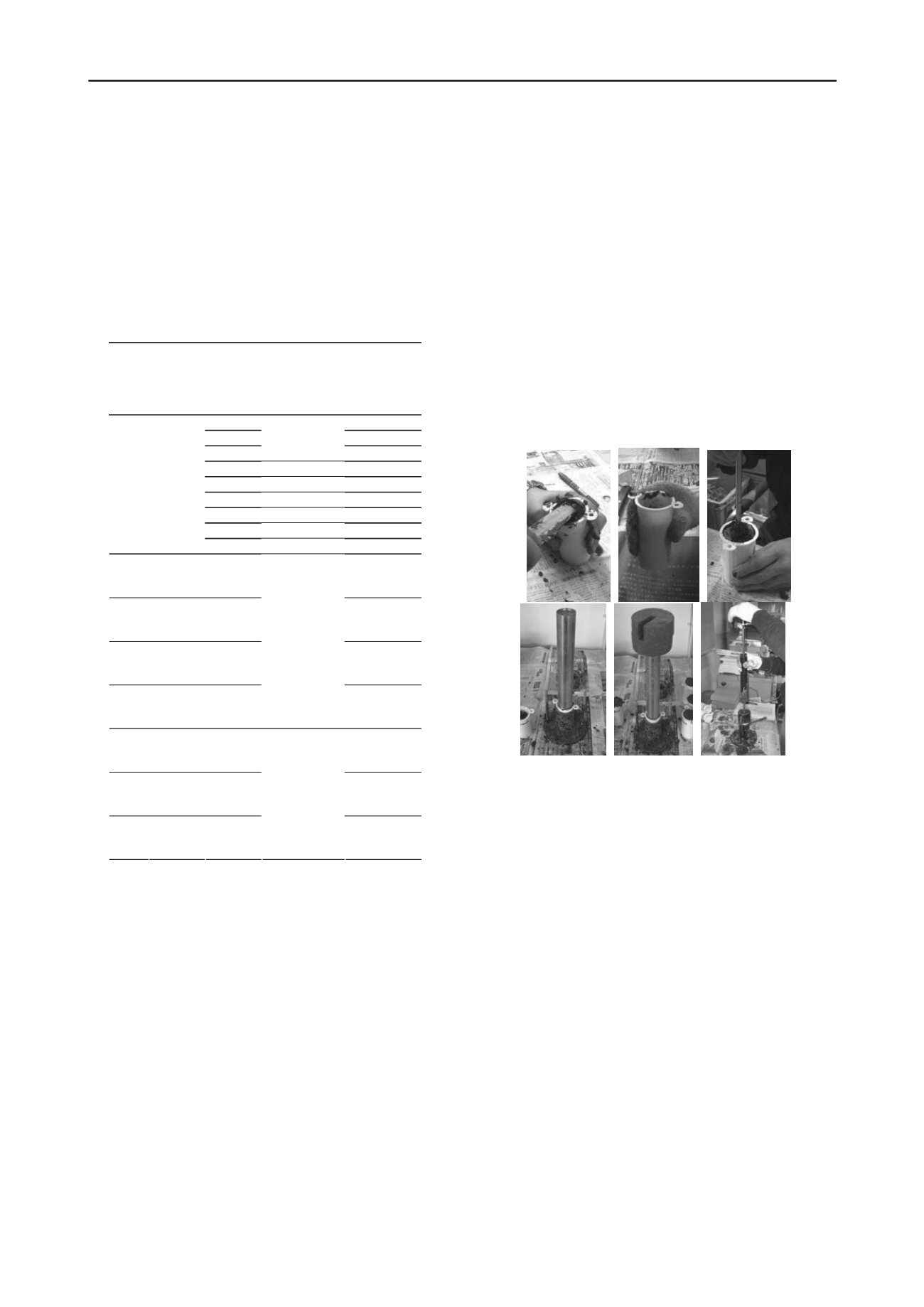
2482
Proceedings of the 18
th
International Conference on Soil Mechanics and Geotechnical Engineering, Paris 2013
clayey Sand (
SS
), Sand and Gravel (
SG
), Pliocene Clay (
PC
),
Black Pozzolana (
BP
), Red Pozzolana (
RP
) and Argillified Tuff
(
AT
). For each soil, different mixtures were produced, varying
the initial water content and keeping constant the cement
content,
a
c
(defined as the weight of the introduced dry cement
divided by the dry weight of the soil to be stabilized).
Specimens with 5 cm diameter and 10 cm height were
employed. Each soil was sieved through a 9.5mm sieve, so that
the maximum grain size of the soil sample would be less than
1/5
th
of the inner diameter of the mold. The properties of the
soil-binder mixtures analyzed are shown in Table 1.
Table 1. Soil properties and Testing conditions.
Soil
type
Gravel-
Sand-
Silt-
Clay
Water
content,
w
n
(%)
Cementitious
grout
Workability
parameter,
Torque,
M
t
(Nm)
72
5,32
66
8,47
60
w/c = 0
a
c
= 5%
17,40
60
a
c
= 20%
29,00
60
a
c
= 30%
40,00
54
a
c
= 20%
61,00
54
a
c
= 30%
75,00
49
a
c
= 20%
96,00
KC
0-14-
42-44
49
a
c
= 30%
120,00
20
13,55
30
4,81
SD
18-24-
34-24
40
2,23
35
9,08
40
4,88
SS
22-40-
20-18
45
3,76
6
11,28
8
5,11
SG
33-40-
14-13
10
3,51
50
10,16
60
5,76
PC
00-00-
64-36
70
a
c
= 10%
w/c = 1
2,34
25
6,97
30
2,37
BP
08-49-
38-05
35
0,21
20
8,34
26
1,60
RP
11-58-
24-07
32
1,08
44
8,22
48
0,60
AT
02-47-
39-12
53
a
c
= 10%
w/c = 0,5
0,20
2.2 Laboratory procedures and testing methods
A Hobart type mixer apparatus was adopted. After placing the
natural soil in the mixer, the water content was adjusted to the
desired value by adding water. Before adding the binder the soil
was homogenised by mixing. The grout made of Portland
cement (PC) and water or the PC in dry form was then added to
the soil and mixed for ten minutes according to JGS 0821
(2000).
Using a commercial device applied directly on the kitchen
mixer apparatus, it was measured the torque required to turn the
impeller in a soil-binder mixture just before the molding phase.
According to the proposed method the workability was
expressed as a torque (
M
t
) applied to mix certain amount of soil-
binder mixture (
V
m
) with set impeller shape (
S
h
) and rotational
speed (
R
s
). In the study were assumed the following parameters:
V
m0
= 3dm
3
;
S
h0
= “K” shape;
R
s0
= 10rpm.
Since the kitchen mixer has a planetary motion, the test was
undertaken continuously on the whole mixture therefore giving
more reliable outputs. For each completed revolution it was
possible to measure the Torque, and for the test it was decided
to set the number or revolution to 10, to obtain more accurate
measures.
Afterwards the stabilized soil was placed into plastic molds
in three layers and compacted using several molding techniques
(Figure 1):
_ No Compaction (namely
N
.
C
.): It simply consisted in
placing the stabilized soil into the mold with a spoon.
_ Tapping, namely (
TA
.): For each layer, the mold was
tapped against the floor 50 times.
_ Rodding, (namely
RO
.): It consisted in tamping each layer
with a 8mm diameter steel rod for 30 times and eventually
pushing down the material attached to the rod.
_Static Compaction (namely
S
.
C
.
25
and
S
.
C
.
50
): Each layer
was statically compressed for 10 seconds by using a heavy rod,
49 mm in diameter. 25 or 50 kPa pressure were applied.
_Dynamic Compaction (namely
D
.
C
.): Each layer was
compacted by a falling weight (1.5 kg) using a special
apparatus. Fall height was set at 10 cm, number of blows at 5.
These techniques are those currently used in most of the
laboratory all over the world (JGS 0821, 2000; EuroSoilStab,
2002; Kitazume et al. 2009).
Figure 1. Molding techniques used: a)
N
.
C
., b)
TA
., c)
RO
.,
d)
S
.
C
.
25
, e)
S
.
C
.
50
, f)
D
.
C
.
To prevent water evaporation from the specimen each mold
was covered with the sealant and stored in special curing tanks
at 95% relative humidity. To reduce the effect of the time of rest
between the hydration of binder and completion of molding on
the specimens properties, according to Kitazume et al. (2009),
all the stabilized soil was molded in less than 45 minutes from
binder hydration. After curing times of 28 days, the specimens
were removed from the molds and then subjected to unconfined
compression tests at a rate of 1.0 mm/min. Unconfined
compression tests were conducted on triplicate samples for each
case (mixture type and molding technique) analyzed.
3 RESULTS
The applicability of a molding technique was evaluated by the
“Applicability index”, which is related to “densest specimens
with the highest strength” and “results repetitiveness”.
For the same mixture a well made specimen has low
cavities/bubbles/voids amount and therefore higher wet density
(
) if compared to a bad made one. Furthermore it was indeed
observed that the specimens produced by different molding
techniques could have similar wet density but very different
unconfined compressive strength (
UCS
) values. For that reason
the
N
-parameter was introduced to condense the indications
given by both parameters,
and
UCS
, into one.
N
is defined as
the mean of the normalized unconfined compressive strength
(
UCS
N
) and the normalized unit weight (
N
) as reported in the
Eq. 1. The
UCS
N
and
N
values for a given molding technique


